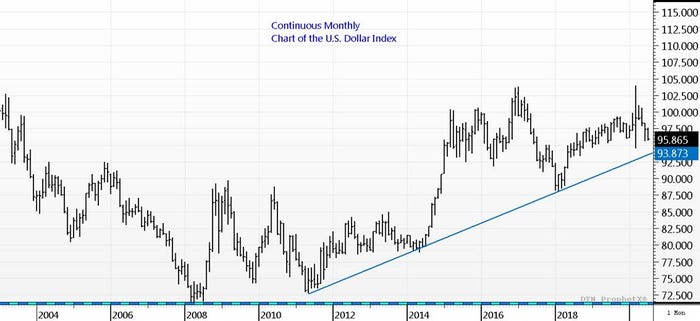
By now you’ve likely seen the memes on social media declaring that we try to quickly skip to the end of 2020 with hopes that 2021 will be a bit more “normal.” The headlines continue to come fast and furious with no shortage of news events in the United States and around the world. When it comes to grain and livestock marketing for your farm, sometimes it feels as though the headlines and tweets are also equally fast and furious, whipping prices in a volatile frenzy.
For example, why is it that a market rumor of wheat being sold to China can make the wheat market rally 24 cents in a day, while an actual legitimate, record corn export sale to China makes the price of corn futures fall 2 cents lower? I hear from producers who struggle with trying to understand exactly what in the market they should be watching. And while it is the year 2020, and anything can happen, here are nine market fundamentals that should be monitored daily to help keep you current on market activity and potential market price direction.
1. Seasonals
Traditionally, when are corn and soybean prices the cheapest? Seasonally, December corn futures and November soybean futures find their price low early the month of September, as harvest begins. Then most times the higher prices for grains occur in early winter or in summer. All commodities have seasonal price tendencies to them. Being aware of these tendencies will help you to have confidence on “when” to pull the trigger for your cash sales.
2. The U.S. dollar
The value of the U.S. dollar has been creeping lower for the past three months. Its value is now approaching a decade long uptrend on monthly charts. Whether or not this uptrend holds or fails is something that trade is very eager to monitor in the months ahead. Remember, when the value of the U.S. dollar is “low,” it makes it cheaper for other countries to import our commodities due to currency exchange rates.

3. & 4. Supply and weather
This pretty much speaks for itself. It is important to not only monitor weather events in the United States, but around the world as well. For the moment, the world is blessed with plentiful amounts of food. Global ending stocks are deemed sufficient. However, we are always at risk of a catastrophic crop failure somewhere in the world. We saw in 2012 how one drought in a major producing region of the world made for a tremendous price rally. If the La Nina predictions come true, that could potentially become a major global event later this year and into 2021.
5. Demand
This could be tricky. USDA is projecting increases in demand for U.S. grain for 2020/21. Exports, ethanol, crush, feed, industrial use are all pegged to be higher than 2019/20. We know how an unexpected trade war, COVID-19 resurgence, and political drama can affect demand. While the demand outlook at the moment is strong, we learned quickly back in March and April that demand can fade fast.
6. China
Look who’s been importing corn!? China – they have been blending new and using up a good portion of the old, nasty, rotten corn that’s been sitting there for years. Some feel that China may be replenishing reserves of many agricultural commodities. It seems as though China may be making good on the Phase One agreement. However, we are always one tweet away from a trade deal blowing up. Remember, regarding China, always watch what they actually do, not what they say.
7. Funds
Keeping an eye on the managed money position is helpful. Every week the government puts out a report with the positions of the funds in the marketplace. It is important to track and monitor their positions. We like to keep track from a historical perspective as well. When they are extremely long (buyers) in the markets, it helps us to try to anticipate when a price high may be in. Likewise, when they are extremely short (sellers) in the market, it is helpful to anticipate when a price low may be near.
8. Energy Markets
After the COVID-19 shutdown during March and April, and the dramatic energy price sell off, energy prices and demand are slowly recovering. The reason we watch them so closely is due to the simple friendly reminder that a third of the corn we grow in this country is used for ethanol. Therefore, essentially, one third of the value of corn is directly tied as an energy. So it’s important to keep an eye on the value of crude oil and gasoline.
9. Technicals
Sometimes looking at charts is like looking at a roadmap. There are many twists, turns, paths and detours. But ultimately the charts help project where prices might go (depending on the fundamental news to justify the price move higher or lower). This is helpful for obtaining price objectives for cash sales.
Balancing current market fundamentals and preparing for any scenario is key for success in marketing. Keep a simple notebook with a daily checklist of the above information. When you make time to check the markets, you now have a better focus of what to monitor. Putting on paper in black and white is helpful, and can help remove some of the emotional pains of marketing. USDA reports, COVID-19 concerns, Chinese demand, various potential wild weather scenarios and a presidential election ensure the remaining weeks of summer will offer many twists and turns regarding the above fundamentals. Be ready!
Reach Naomi Blohm: 800-334-9779 Twitter: @naomiblohm and [email protected]
Disclaimer: The data contained herein is believed to be drawn from reliable sources but cannot be guaranteed. Individuals acting on this information are responsible for their own actions. Commodity trading may not be suitable for all recipients of this report. Futures and options trading involve significant risk of loss and may not be suitable for everyone. Therefore, carefully consider whether such trading is suitable for you in light of your financial condition. No representation is being made that scenario planning, strategy or discipline will guarantee success or profits. Any decisions you may make to buy, sell or hold a futures or options position on such research are entirely your own and not in any way deemed to be endorsed by or attributed to Total Farm Marketing. Total Farm Marketing and TFM refer to Stewart-Peterson Group Inc., Stewart-Peterson Inc., and SP Risk Services LLC. Stewart-Peterson Group Inc. is registered with the Commodity Futures Trading Commission (CFTC) as an introducing broker and is a member of National Futures Association. SP Risk Services, LLC is an insurance agency and an equal opportunity provider. Stewart-Peterson Inc. is a publishing company. A customer may have relationships with all three companies. SP Risk Services LLC and Stewart-Peterson Inc. are wholly owned by Stewart-Peterson Group Inc. unless otherwise noted, services referenced are services of Stewart-Peterson Group Inc. Presented for solicitation.
The opinions of the author are not necessarily those of Farm Futures or Farm Progress.
About the Author(s)
You May Also Like






